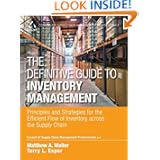I came to the project with a math degree, some programming expertise, practical experience simulating production lines, optimizing distribution networks, analyzing investments and with no real idea of how to get the job done. The books I managed to get my hands on gave you some idea how to use such a system but no real idea how to build it. They left out all the hard/useful bits I think. So, I set about to work it out for myself with a lot of simulation models to validate that the outputs made sense.

I still work occasionally in inventory modeling and I'll be teaching some components this fall, so I have been eagerly awaiting this new book : The Definitive Guide to Inventory Management: Principles and Strategies for the Efficient Flow of Inventory across... by CSCMP, Waller, Matthew A. and Esper, Terry L. (Mar 19, 2014)
Full disclosure here: one of the authors, Dr Matt Waller is a friend and colleague of mine. He brings an astonishing level of expertise to many areas of supply-chain management and inventory modeling is clearly no exception. Together Matt and Terry Esper have produced a book that (had I possessed it 15 years before it was published) could have short-cut my inventory modeling project by approximately 6 months.
This is not a long book, not quite 200 pages in fact, but it is no lightweight. If you just want an overview of the topic you could skip the math, but my guess is that if you do that, you will never really understand. The math is not particularly hard and it's presented in a sort of hybrid math/Excel fashion that I find easy to follow. I'll also say that I hit my first "ahah!" moment before I got to page 20. I won't embarrass myself by telling you what it was but something that had bothered me for years suddenly clicked into place.
Unlike most discussion on this topic, this book looks at inventory modeling from the manufacturer's or supplier's point of view right through to the retail shelf. They also provide a number of means to estimate components of inventory from historical data so you can assess how well your planning and execution system are tracking to plan: something I was aware of but had never really thought through how useful it could be. Details on how to conduct your own simulation studies in Excel and an overview to the most commonly used forecasting approaches that feed the inventory models round it out.
It's all here, what you need to understand (and if you so wish, build) a system to optimize your inventory holding. I highly recommended it.

No comments:
Post a Comment
Note: Only a member of this blog may post a comment.